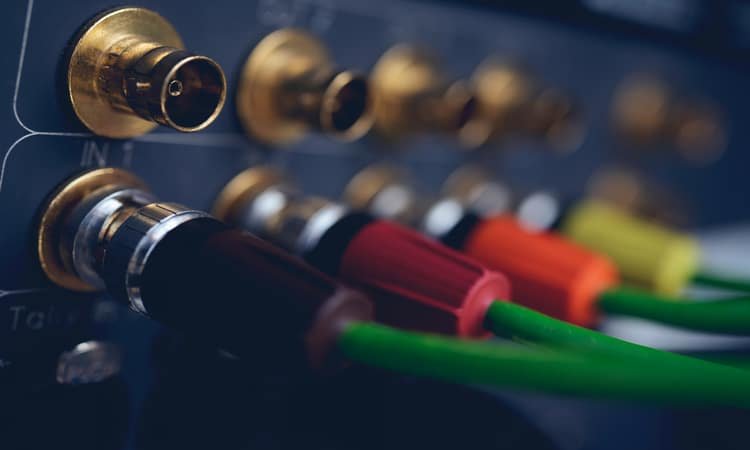Types of CCTV Camera Cables

What do you mean by surveillance? Here’s the thing- surveillance is like an extra layer of protection.
And CCTV cameras are the widely used tools for this surveillance.
However, it’s important to get the best out of CCTV cameras. Because low-quality output means security risk.
But getting the best output from CCTV cameras is impossible without using good cables. But there’s more to this. To pick the best security combo for your house or office you have to know the accessories in detail.
For that reason, we’re here to discuss types of CCTV camera cables.
There are basically 5 types of security camera cables out there. We will discuss each of those in here with specific pros and cons.
Type 1 of 5: Coaxial Cable
So, what is a coaxial cable?
These cables are basically thick ropes of wires or in other words nonmetallic fibers. These fibers have an insulated core of stranded/ solid wire. And this core is surrounded by outer flexible wire braids (insulated).
Now that we have the basic idea about coax cable parts, it’s time to move on. So, let’s look at coaxial cable advantages and disadvantages-
Pros
High Quality: If you want to trust something, then Coax cable quality is one of those few things. These cables last longer compared to other types of cables in here. The building quality of this cable is tear and wear-resistant.
Versatility: These cables are compatible with a wide range of transmissions. You can transmit all kinds of radio frequency signals with this cable.
Distance: Because of the build quality, these cables can transfer data to a long physical distance than other cables.
Cons
In this part we have only one complaint against coax cables. That is coax cable costs are relatively higher than other cable types. So, taking media signals to a long physical distance becomes a lot tough.
Type 2 of 5: Siamese Cables
Basically, if you attach two power cables with a coax cable, it becomes a Siamese cable. However, if your recording device and the power source aren’t at the same place, then you might need to do some cable splitting.
Pros
Although Siamese cables are one type of coax cable, there are some specific benefits of this. So, we’ll explore those extra benefits here-
Versatility: The extra benefit here is the power transferability. So, you won’t need to shake your pocket for extra power cables.
Data Integrity: Some CCTV cables show undue interference while crossing paths with power cables. But you won’t find this issue in a Siamese cable for security camera.
Adaptability: These cables are compatible with several electronics devices. Some of the mentionable devices are CCTV, wired security system, surveillance cameras, and specially RG59 coaxial cables.
Cons
These cables are one of the most complicated cables in case of handling, installing and operating.
Type 3 of 5: Twisted Pair Cables
Just as the name suggests, this cable has a pair of insulated copper wires twisted together. So, let’s look at the pros and cons of twisted-pair cables-
Pros
Space Efficiency: This cable has only two wires inside it. Which means less space occupation than the coax cables.
Signal Integrity: If you’re worried about crosstalk and electromagnetic inductions between pairs of wires, then this cable will relieve your tensions. This cable ensures one thing during its operations. That is the integrity of signals.
Cons
This cable lags a bit behind on the durability issue. During natural calamities, there’s a high chance that these cables will receive a toll.
Type 4 of 5: Optical Fiber
The great thing about CCTV camera cables is that you can assume a lot about the cables from the names. So, you might have guessed from the term optical that this cable has something to do with light. And you’re right.
Optical fibers use transparent glass or plastic strands as data transmitting fibers. Through these fibers, data are transmitted as light.
Pros
Speed: When talking about the pros of optical fibers, it’s hard not to talk about the speed of data transmission. This feature truly makes optical fiber outstanding from all the other cables. Because of using light as the transmitting signal, this cable gives out excellent efficiency.
Large Capacity: Again because of using light as the data transmitting medium, optical fibers can handle a large amount of data.
Cons
Our number one con here is the cost. This is the reason why people don’t prefer using optical fibers as CCTV camera cables.
Type 5 of 5: Video Power Cables
These cables are made for transmitting video from CCTV cameras to the system. That’s not all- these cables also supply DC power to the whole Closed Circuit Television system. Basically these cables are am IP camera cable type that supplies both data and power at the same time. So, let’s explore the pros and cons of video power cables.
Pros
Simplicity: This is the number one reason for using these cables. Video power cables are super easy to install and use. Just plug in these to the dedicated ports and you’re done.
Convenience: These cables transmit video and supply power at the same time. So, if you talk about convenience, these cables are the best.
Cost Efficient: If you talk about costs, then these are truly unbeatable. If you want to build up a low-cost CCTV surveillance, then this is your cable.
Cons
Because of the durability issue, these cables are not so popular choice for outdoor surveillance. Moreover, these cables only work within a limited range.
End Note
At this point, you can easily deliver a lecture on different types of security camera cables. We believe that with this information, you can easily choose a great cable among lots of CCTV cables.
However, don’t get all idle on choosing the cables. There might be a possibility that your life depends on it. So, good luck with cables. Happy surveillance.
